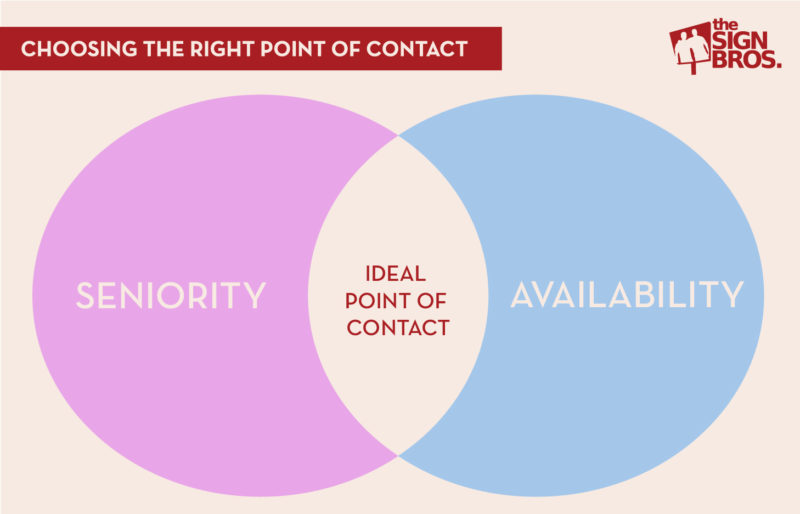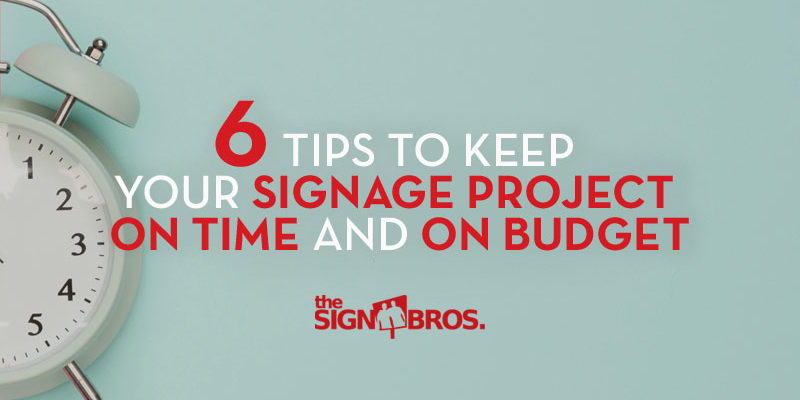Whether it’s designing way-finding signs for a new hospital, or an outdoor monument sign for a local business, signage projects have lots of moving pieces that require planning and close management in order to be successful. This post will outline 6 things that a client and/or a sign company should keep in mind in order for a project to run smoothly.
1) Keep as Few Decision Makers Involved As Possible
Whether you’re making decisions about signs, or where to get lunch, the more people involved in the decision making process the slower it will go, and the less likely it is you’ll reach a conclusion. Make sure only to include those necessary in the decision making process, but make sure to include everyone that’s necessary.
2) Establish a primary point of contact
The sign company should have one primary point of contact to manage the project, and your organization should have one as well. Having one person in charge of communication on either end will keep your signage project from descending into a bad game of telephone. The point of contact should be the most senior person possible with the largest margin possible to handle the project. If the point of contact has the margin to manage the project but isn’t senior enough, then they won’t be able to call the shots, and will be constantly waiting on other people to get things done, thus delaying the project. If the point of contact is senior enough to manage the project, but doesn’t have enough margin, then they won’t be able to dedicate the time needed to nail down details and delay the project.

3) Nail Down Details On The Front End
Sign Projects can be incredibly detailed endeavors. Make sure you think through all the necessary details BEFORE purchasing signage. Here are some of the things you need all your decision makers to think about and agree on before beginning your project:
a) What is the Goal/purpose of this signage project?
Assuming decision makers all understand the goal and purpose of a signage project will avoid headaches and disappointment down the road. Make sure to define if this project is:
- a long term or temporary solution
- primarily for function or aesthetic
- who this signage is targeting
- how this signage project fits into the overall brand identity of the organization
- a part of a larger signage project
B) What is the budget for this signage project?
Your budget will have a huge impact on the materials your signs can be made of, how many and how large they can be, how long they will take to build, and even what goal(s) this project will achieve.
Depending on cost, your project may have to be a temporary solution until you can afford a long term one, or you may only be able to afford phase 1 of your signage goal.
C) How long will this signage project take?
Take a look at your calendar and work out with your sign company how long the project will take and when it will happen. If your organization has down times and busy seasons, consider how that will affect your signage project. Is your signage project part of a larger construction project? You will need to work with your contractor to coordinate your signage project with construction.
D) installation?
For smaller projects, signs could be installed in-house, but for large, or more complex projects, the sign company should be able to install the signage. There will be a cost for this service that must be accounted for. You should be able to have open conversation about your organization’s sign installation capabilities and budget and find an affordable and efficient installation solution. Before the sign company begins producing the signs, either they, or a qualified person from your organization should do a site survey in order to assess where the signs are going, how they will need to be installed, and how they will need to be built.
E) How Long Will Your Signage Solution Last?
The sign materials will depend heavily on your budget, purpose, and location (interior or exterior) of your signs. You need to make sure all decision makers are aware of how long your proposed signs will last. If this project is intended to be a long term solution, how long will the sign materials last before they need to be replaced? Do they require special maintenance, or cleaning? If you can only afford cheap signage materials, you will have to spend more money sooner to replace them. If this is a temporary solution, how long do they need to last before they can be replaced with a long term solution?
4) Keep Details Organized
It’s not enough to talk about these details. Even with relatively simple projects, people can forget who said what and details can slip through the tracks. In order to hold everyone accountable and keep the project on track, there has to be a paper trail. Before you start nailing down details, choose a method for making that paper trail. These days, there are lots of options to keep track of projects: email, paper, project management tools, or Microsoft Word. Email threads can be cumbersome and get lost. The last thing you want is to have to dig through months of emails to figure out who said what. Paper can get lost and can’t be accessed by people in different places quickly. There are lots of project management tools out there (some better than others), but we recommend using Google Docs.
Google Docs is free and can be used by anyone. Unlike Word, it isn’t stored on individual computers, but in the cloud. This means that an unlimited amount of people can access and edit a document at the same time from a phone, tablet, or computer. You can make comments and track changes in real time. With Google Docs, everyone can be completely up-to date with the project as it happens. You can even assign tasks to people with email reminders that go out at specified times. You don’t have to worry about out of date documents, or old email threads. All you need to start working with Google Docs is to create a google account (which you might already have).
If Google Docs isn’t for you, Basecamp and Trello are two other popular and effective project management tools. Whatever method you choose, make sure everyone is familiar with it, and understands what they need to do to contribute and stay informed on the project details as they develop.
5) Get Approval On The Project Before Ordering
Make sure that every decision maker that has to be involved has signed off on the final details of the project. They should at least be aware of the budget, timeline, and proposed final product. It’s best to sit down with all the decision makers and review all the agreed upon details one last time. Once approval is reached, make sure the approval is written down somewhere that you can reference in the future so the decision makers can’t deny their consent.
Sign projects don’t just have to be approved by the leaders of the organization ordering them, but also by the local city or county government. While the sign company should handle this, if a sign project isn’t approved by your local government, then you might have to cancel the whole thing. Make sure to get your local government involved early, and that they are aware of and approve of all the project’s details.
6) Give Yourself Margin
Even with detailed planning, surprises can happen. The more complex a project is, the easier it is for something unexpected to throw a wrench in your plans. Make sure you give yourself more time than your originally expected. If the signage project is a part of a larger construction project, construction could run long and eat into the time you allotted for signage. Even the best sign companies can make mistakes. The last thing you want is to throw your project into a bind if the sign company is a day or two behind. The sign company should walk you through the appropriate amount of time to allot to a project in order to create the appropriate margin of time.
As far as cost goes, if a sign company makes a mistake, it should be on their shoulders to eat the cost, but if you realize that you need more signage, that is on you to pay for the extra work. It’s a good idea to leave a little room in your budget in case unanticipated signage needs arise.


No comments yet. You should be kind and add one!
Our apologies, you must be logged in to post a comment.